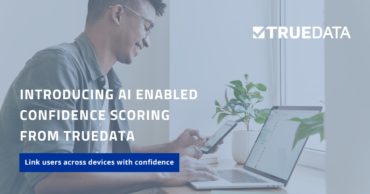In my previous blog article, I looked at the changing data & consumer privacy landscape, the associated technical changes made (or proposed) by Apple and Google, and the challenges these pose for Brands, Publishers, and the AdTech industry. If hindsight is 20/20, foresight is – at best – 50-50. Predicting the future of an area as complicated as digital advertising and identity is often a fool’s errand. However, it’s what we are all compelled to do today to protect our businesses. With that disclaimer, here’s my attempt to make sense of the facts we have (and look foolish):
At the highest level, the shift towards privacy and transparency, and the associated changes to cookies and IDFAs, are creating a need for new Identity solutions and standards. However, more user transparency and controls will inherently mean we’ll have more users who opt out (or don’t opt in). This creates two distinct futures and opportunities for innovation: one contextual and one addressable.
The increase in anonymous users who opt out, don’t opt in, or simply aren’t addressable, is driving the need for new contextual targeting and measurement solutions. At first glance, many will dismiss these solutions as “so 2005”, but in today’s data- and ML/AI-rich world, contextual advertising has the potential to reach new levels of performance while remaining privacy-friendly.
While we know we’ll have more anonymous users, the proven performance of addressable ad targeting and measurement solutions has earned them the lion’s share of brand ad budgets. Likewise, publishers have jumped to sell their inventory in addressable ways given higher ad CPMs and the need to compete with the addressable solutions of walled gardens. To continue to support addressable ad monetization, targeting, and measurement on the open web, the industry needs new approaches to identity and addressability.
We can break the future of identity and addressability solutions into several categories: existing “open internet”-based identifiers, centralized “private” ID solutions, new open-source identity solutions, and “one-way” walled garden and client-side Identity solutions. Let’s take a closer look at each of these categories:
Existing “Open Internet”-Based Identifiers
In addition to third-party cookies & MAIDs, there are other IDs, such as IP addresses, that support basic Internet operations, interoperability, and addressability, as third-party cookies and MAIDs were originally created to do.
What’s good about these identifiers? Identifiers such as third-party cookies, MAIDs, and IP addresses have been the traditional basis of identity and addressability. They have driven billions of dollars of US ad spend and the shift of dollars towards programmatic advertising. Historically (prior to third-party cookie changes), these identifiers have provided the highest match rates for ad monetization, targeting, and measurement given they were available to all users by default. Further, because of their open accessibility and free nature, these solutions are favorable to fuel interoperability, innovation, and competition.
What’s not so good about these identifiers? As we’ve seen, even the most privacy-centric implementations that use Internet-based identifiers require technological support from browsers, operating systems, and/or Internet Service Providers. For example, even a “perfectly transparent” and privacy-centric third-party cookie solution for basic re-targeting (i.e., explicit consent, with GDPR-level purpose+vendor transparency+choice) is foiled when third-party cookies are removed.
What we can expect. While third-party cookies are on their way out, MAIDs and other Internet IDs are still here. Ideally, we need federal legislation (rare words for us, as we’re capitalists, but this one feels critical) that:
Unfortunately, we’re likely at least a year or more away from any federal legislation, and it seems unlikely that such legislation would go far and deep enough to give our industry comfort that we can continue to rely solely on Internet IDs. So, while we believe the industry will and should continue to leverage Internet IDs to the extent they’re available given the scale and economic benefits, the industry needs to couple them with alternatives.
“Private” ID Solutions
This category includes solutions such as LiveRamp’s ATS, Kochava Identity Locker, ID5, Epsilon’s CoreID, ZeoTap’s ID+, BritePool, Neustar Fabrik, Verizon’s Connected ID, and many others. These private ID solutions are elegant, privately-maintained offerings that aim to let publishers and brands “identify” users to connect ad supply and ad demand at a 1:1 level.
What’s good about these identifiers. Unlike cookies or MAIDs which rely on browsers and mobile operating systems to create and support them, Private ID solutions have no external dependence. Further, these solutions have the potential to be privacy-centric and secure, as ID generation can be directly aligned to consent.
What’s not so good about these identifiers. Private ID solutions are generated in different ways: some use email-based registration as the input for each ID, while others leverage technographic profiles or “fingerprints.” There is a risk for each of these private solutions in future legislation. Trade organizations and browsers or operating systems could enact and enforce policies or Terms of Service to “reject” specific IDs and companies.
For example, many publishers have reported signals from Apple that it will reject apps from the AppStore that use certain ID mechanisms that aren’t directly in line with its updated guidelines and associated Terms of Service. This is supported by Apple’s moves against Fingerprinting and their app rejections for “not offering Apple Sign-on”. Finally, even if these solution pass privacy muster, any ID has little or no value for 1:1 advertising until it reaches “scale” or “saturation” on both ad supply (SSPs/publishers), and ad demand (brands/DSPs).
It’s like Uber; it would not be very useful to be an Uber rider (brand+ad budget) if there weren’t any drivers (pub+ad supply) on the Uber Platform (ID standard). LiveRamp has a major head start on the business development cycles needed to get to saturation across demand and supply sides, but still, the “addressable ad impressions” available using ATS/IDLs are a small fraction of the addressable impressions available with cookies or MAIDs as the identifier today.
What we can expect. Long term, there is definitely a place for private ID solutions. This area has the potential for a strong protocol network effect as other companies, marketplaces, and platform network entities adopt and rely on that protocol. Given this is likely a winner-take-most market, with multi-billion dollar US TAM, it will be heavily contested by entrenched incumbents, startups, and venture capital. That said, it will take at least 12 to 24 months before we see which of these solutions truly can achieve scale/saturation, and It will be a business development blitzkrieg to get there
Our prediction is that this space won’t produce more than two or three true winners long term that will be capable of supporting “global” addressability in the programmatic ecosystem (i.e., connecting supply and demand 1:1). The rest will fail due to competition and regulation, or will be relegated to be internal IDs within a CDP, MMP, or other smaller data ecosystem; however, this value will be much smaller as they will have to revert to, match to, and interoperate with the “winning IDs” for any external ad monetization, targeting, or measurement.
New Open-Source Identity Solutions
Next are open-source standards and solutions like TheTradeDesk’s UID 2.0. In recent months, UID 2.0 has won the favor of IAB ReArc, as well as drawing support and tech investments from Nielsen, Criteo, and numerous others. At the end of October, even LiveRamp announced that it would enable interoperability between LiveRamp ATS and TTD UID 2.0.
What’s good about these identifiers. These solutions provide all of the same benefits as private ID solutions in connecting ad supply and ad demand 1:1, but given their open-source nature, they don’t create network effects and moats that dramatically advantage one private company. As a result, these solutions should have an easier time getting widespread adoption and scaling rapidly – especially given that they’re likely to be free or consortium-based. We’re already seeing early signs of this phenomenon playing out with TTD UID 2.0.
What’s not so good about these identifiers. Like any new ID, there is a risk that these solutions could face privacy or regulatory headwinds. For TTD UID 2.0 specifically, however, with the IAB Tech Lab putting its support behind it, and with its single sign-on (SSO) approach to authentication, transparency, and consent, we see a low-level overall risk versus private ID solutions.
What we can expect. While we believe there will be multiple identifiers in our future, we believe there is likely to be a single transparent, SSO-based, open-source, and universally accessible ID solution that fuels the vast majority of 1:1 ad demand/ad supply transactions. While “optimized” versions of the open-source standard may include alternate ID types, we believe that the baseline open standard is a critical keystone for our industry. Today, if we had to bet on any new Private ID or Open ID solution we’d bet on TTD UID 2.0.
“One-way” Walled-Garden and Client-Side Identity solutions
Last but not least are the “One-way” Identity and Client-Side solutions. To support their targeting, onboarding, and measurement solutions, companies like Facebook, Google, and Apple all use their privileged positions to create internal Identity solutions using their massive footprints of registered users, devices, OSs, and/or Browsers. Other solutions in this category are the “client-side Identity solutions” such as the “Flocks of Birds” proposals like Sparrow & TurtleDove, and now DoveKey, as well as LiveRamp’s new ATS On Device. All of these are proposals for how to enable a level of addressability (even if segment-based) with minimal data ever leaving a user’s Browser or Mobile Device.
What’s good about these solutions. Mitigating potential data leakage is a critical benefit of walled gardens and other “one-way” client-side identity solutions, and why these proposals are commendable. Typically these solutions only allow person/household-based data to flow into their ecosystems, with only aggregate reporting and measurement flowing out. Abstractly it’s a great approach from a privacy standpoint.
What’s not so good about these solutions. Unfortunately, many of the proposals and changes by Browsers and OSs are being made in the name of privacy, but under the surface, these are self-serving. The outcome is these solutions stifle open addressability and innovation, and further entrench their position as “the only purveyors of addressable advertising”. Finally, there are major questions on if the new Client-Side solutions can support critical and basic use-cases like frequency capping, and whether the increased hardware & bandwidth needs of the client-side solutions are truly viable.
What to expect. Barring regulatory or anti-trust outcomes that prohibit them, the Identity solutions built into walled gardens are likely here to stay, continuing to enable the addressable ad solutions within those platforms. Brands will continue to leverage these given their proven performance and scale but will seek to identify and test other addressable solutions that can help decrease Brands’ dependence on these walled gardens. On the other side, One-way “client-side” solutions have a long road ahead. Given their reliance on collaboration and consensus with browsers and OSs within large forums like the W3C, and the challenging technology & bandwidth requirements of these solutions, we’re likely at least 12-24 months away from a market-viable implementation.
TL;DR
However things shake out, we’re highly optimistic that our industry will find a path to preserve addressability given the consensus we’re seeing around privacy, transparency, and consent. To make that happen, however, will require a nuanced transition across different IDs over time, making a multiple-ID approach critical for brands, publishers, and the AdTech industry to manage through the transition.
Over the next two years or so, leveraging privacy-centric implementations of third-party cookies (until late 2021), MAIDs (IDFAs will still be the most scalable ID on iOS, even with the ATT feature, given Apple’s guidance, AAIDs are unchanged today), and other traditional Internet identifiers will be key as these will continue to provide the most scale until truly deprecated (like third-party cookies).
Simultaneously, we know the industry is rapidly working on new private and open-source identifiers. Brands, publishers, and AdTech will need to monitor how each ID solution is progressing towards scale and saturation, as well as how regulators, trade organizations, and Apple and Google are reacting to these technologies.
By late 2021, when Chrome is expected to put the final nail in the third-party cookie coffin, having the ability to also buy (brands/DSPs) or sell (pubs/SSPs) against at least one open-source or private ID will be a critical step to maintaining addressability. Luckily for publishers, SSPs like PubMatic have simple pre-bid ID modules that will fetch a number of IDs to maximize “targetability” and auction dynamics, often for free. This isn’t truly beneficial until brands/DSPs are actually bidding against those IDs at scale with real media dollars; however, it’s an easy future-proofing step for publishers as long as they are confident in each identifier’s privacy approach.
The outlook for brands is more cautious, however. Because private ID solutions are most likely to charge advertisers for “onboarding” their data, brands will need to invest carefully in private ID solutions knowing that many may not reach scale, or may face privacy headwinds. Also be sure to consider the benefits of leveraging open-source solutions, or the “optimized” versions of open-source standards that will surely crop up.
The year 2021 is sure to be eventful. Sit back and grab your popcorn and/or roll up your sleeves; it’s going to be an exciting time as we rebuild a better advertising ecosystem to support a more transparent and open Internet.



Subscribe For Updates